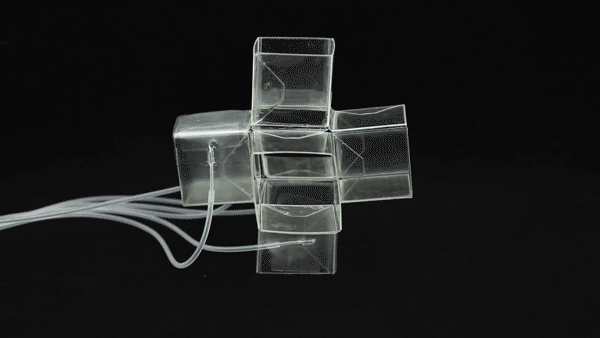Folds and Changes Shape On Its Own
Imagine a house that could fit in a backpack or a wall that could become a window with the flick of a switch.
Harvard researchers have designed a new type of foldable material that is versatile, tunable, and self-actuated. It can change size, volume, and shape; it can fold flat to withstand the weight of an elephant without breaking, and pop right back up to prepare for the next task.
The research was led by Katia Bertoldi, the John L. Loeb Associate Professor of the Natural Sciences at the John A. Paulson School of Engineering and Applied Sciences (SEAS); James Weaver, senior research scientist at the Wyss Institute for Biologically Inspired Engineering at Harvard University; and Chuck Hoberman of the Graduate School of Design. It is described in Nature Communications.
“We’ve designed a 3-D, thin-walled structure that can be used to make foldable and reprogrammable objects of arbitrary architecture, whose shape, volume, and stiffness can be dramatically altered and continuously tuned and controlled,” said Johannes T.B. Overvelde, a graduate student in Bertoldi’s lab and first author of the paper.
The structure is inspired by an origami technique called snapology, and is made from extruded cubes with 24 faces and 36 edges. Like origami, the cube can be folded along its edges to change shape. The team demonstrated, both theoretically and experimentally by a centimeter-scale prototype, that the cube can be deformed into many different shapes by folding certain edges, which act like hinges. The team embedded pneumatic actuators into the structure, which can be programmed to deform specific hinges, changing the cube’s shapes and size, and removing the need for external input.
The team connected 64 of these individual cells to create a 4-by-4-by-4 cube that can grow, and shrink, change its shape globally, change the orientation of its microstructure, and fold completely flat. As the structure changes shape, it also changes stiffness — meaning one could make a material that’s very pliable or very stiff using the same design. These actuated changes in material properties add a fourth dimension to the material. “We do not only understand how the material deforms, but also have an actuation approach that harnesses this understanding,” said Bertoldi. “We know exactly what we need to actuate in order to get the shape we want.”
The material can be embedded with any kind of actuator, including thermal, dielectric, or even water.
Learn more about the new material in the Harvard Gazette.
News via Harvard










Leave a Reply